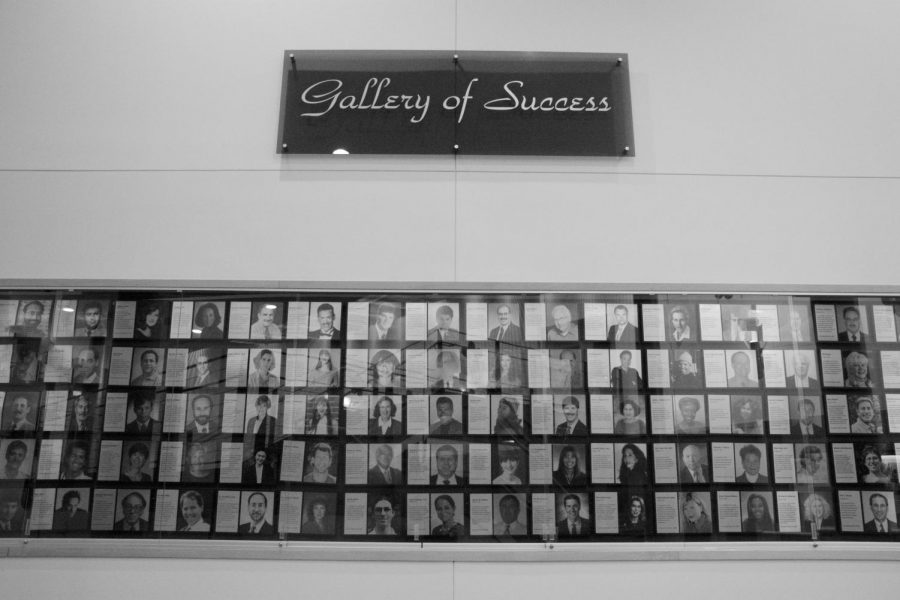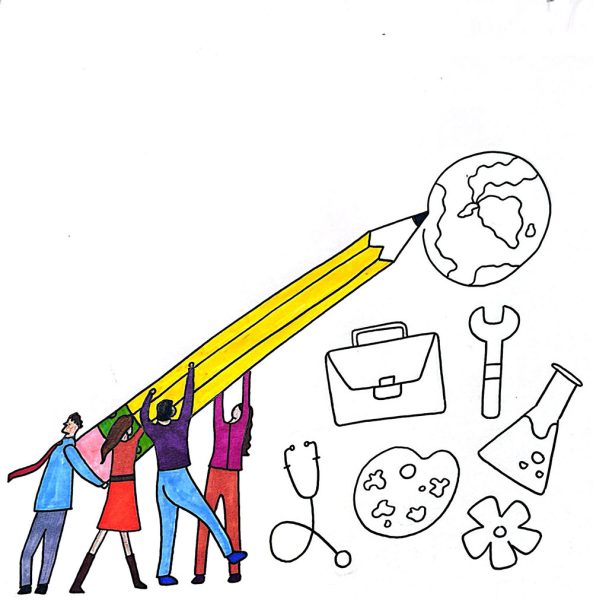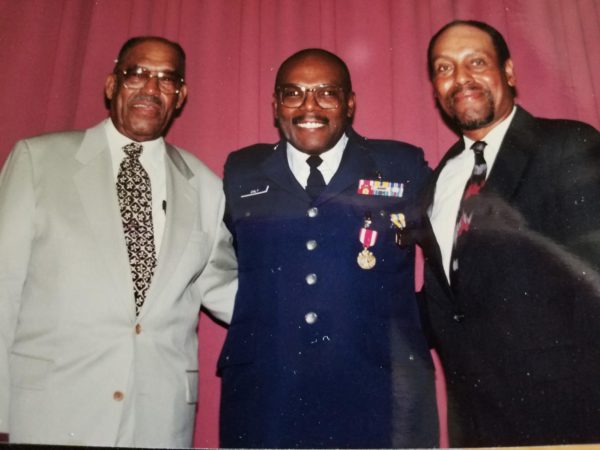Reconsidering How Beachwood Defines Success
“To develop intellectual entrepreneurs with a social conscience,” the school district’s mission statement serves as the welcome sign for students as we walk into school every day.
Across the room, on the north wall of the atrium, a display of 129 plaques of Beachwood alumni are neatly aligned under the cursive words, “Gallery of Success.”
But this display begs the question – are these the graduates who were successfully developed into “intellectual entrepreneurs with a social conscience” as school leaders hoped? Do they represent the epitome of success?
The names and faces in the “Gallery of Success” watch over each student who enters the school, offering a sense of successful heritage and aspiration to the halls of Beachwood. Besides serving as interesting reading material to pass the time as students wait for their bus, most current students do not know what the “Gallery of Success” actually is.
Paula Rollins, a 1971 BHS graduate, is the coordinator of the Gallery of Success. There is a lengthy nomination process for each applicant and certain criteria for admission.
“Nominees must exemplify leadership, service, humanitarianism, creativity, courage, or career contributions that have benefited others,” Rollins said.
Reading the biographies on the plaques, it is clear that the alumni in the Gallery have truly accomplished admirable things. From working with burn victims, helping Hurricane Katrina survivors, researching cancer, preserving the memory of the Holocaust, and teaching race/equality studies, the individuals in the Gallery can inspire current students to achieve great things in their own futures.
Students are reminded that these accomplished adults were once confused and angry teens like ourselves wandering the halls of BHS.
The Gallery of Success was established in 1985, and new members are inducted every three years. The twelfth induction ceremony was planned for April 2020 but was canceled due to COVID-19.
“We have 20 people on the selection committee…” Rollins explained. “…two students, former teachers, current teachers, city citizens, city representatives– people of all ages.”
Since Rollins assumed responsibility for the project in 2000, the committee has admitted ten people in each induction year from a pool of forty to fifty nominees.
When the induction ceremony takes place, new Gallery members return to BHS and are celebrated during all-day events.
“It’s a really big deal,” Rollins said. “It’s a big deal for the people who will be honored, their families and friends, and for the student body as well.”
Social studies teacher Pam Ogilvy, who has attended multiple induction ceremonies, described the inductees’ speeches during the induction ceremonies:
“Sometimes they try to make connections with their experiences in high school and where they are today,” she said. “Maybe there was a teacher who impacted their life, or there was an obstacle that they overcame. Those are the stories kids seem to connect with the most because it helps them see beyond their immediate environment and the potential of what can happen in the future.”
Many of the inductees are doctors, hold advanced degrees, or are “classic” professionals such as lawyers, writers or entertainers.
“These don’t get in because of their job, it’s because they go above and beyond,” Rollins made sure to mention.
While it’s clear many Gallery inductees have distinguished themselves in their fields, their careers are overwhelmingly white-collar and high profile.
It is that reason Sharon Weisman appreciated the honor the most.
“I was (one of) the first [school] teachers – that’s what made it special,” she said.
Weisman, who has been an ASL teacher at Beachwood for 25 years, was inducted into the Gallery in 2014.
“I was nominated by people who thought what I was doing for the community and for the students was important,” she said.
Weisman has committed her life to make the deaf community feel more included in the world.
“How do we measure success? All these people were on the wall – they are directors and actors and writers- all these things we value as a society, but there weren’t [many] teachers,” Weisman added. “We put so much emphasis on our kids and their education, but then why aren’t we rewarding the people that value all this?”
Her words got me thinking of the other hundreds of people who applied and were not accepted to the Gallery, or the thousands of other Beachwood graduates who haven’t taken the trouble to apply or be nominated. What should Beachwood High School’s measurement of success mean for current students as they pass the Gallery? Is success limited to so-called “professional success” valued by society?
What if a student wants to be a farmer, blacksmith or prep cook? They don’t see any role models in the Gallery that can serve as inspiration. Students of color do not have many people who look like them in the Gallery because the members are overwhelmingly white. The board is 5% Black, 1.5% Asian, and 42% female.
Acknowledging that the district has historically been majority white, this still makes it difficult for students of color to find very many role models in the Gallery.
While the Gallery does not explicitly define what success looks like, the inclusion of certain alumni, and the obvious exclusion of others, limits the scope of what students perceive as success.
Armond Budish graduated from BHS in 1971 and was inducted into the Gallery twenty years later. Since 2015, he has served as Cuyahoga’s County Executive but has come under scrutiny in recent years for a variety of reasons, many of which stem from the short-sighted effort to save money by consolidating jails in Cuyahoga County.
Students see his face every day under the powerful word “Success.” Is it “success” to use the powers of public office to intimidate and force through an agenda? It is obviously unfair to highlight one questionable inductee; however, it is clear that success is not absolute or as clear-cut as the concept of the Gallery may imply.
One could argue that the selection-committed gallery understands this. Just because you are not selected into the Gallery does not mean you aren’t successful, it just means you’re not successful by Beachwood’s definition of success, or that there are others who are more so. But, is it a school’s job to place judgment on its own graduates’ success?
Naming the wall “Notable Alumni” or “Featured BHS Graduates” would make much more sense, but the fact that the word ‘success’ is used insinuates there are specific successful criteria that only a few have met.
“High school is the best,” Ogilvy said. “We are helping shape humans as they decide where they are going to go, what are they going to do. And once they find it, it’s a remarkable thing as they come into their own.”
“From an educator’s perspective, we just want to see our kids doing what they love and care about, Finding out who they are,” she added.
More than learning about chemical bonds or the quadratic formula, high school develops us from naive children to independent adults prepared to take on the world in an honest and dignified way. Beachwood defines that goal as “Creating intellectual entrepreneurs with a social conscience.”
Once Beachwood’s graduates achieve that and find meaning within their own lives, they have succeeded. This reality is much less exciting than receiving a trophy and giving a speech. It is, however, this definition of success that is best suited for a healthy school environment where everyone can succeed.













